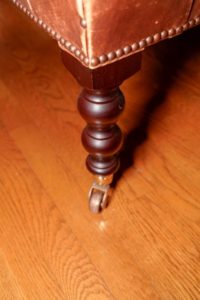 Your family holiday greeting card might bear a photo of your family on your antique sofa, in a room filled with antique furniture. Or maybe a photo of your beloved dog on the Persian rug. Let’s hope you don’t need to sell that stuff in 2020. I mean the furniture and rug, not the kids and the dog!
Your family holiday greeting card might bear a photo of your family on your antique sofa, in a room filled with antique furniture. Or maybe a photo of your beloved dog on the Persian rug. Let’s hope you don’t need to sell that stuff in 2020. I mean the furniture and rug, not the kids and the dog!
People often ask me, “How do I know if I have valuable antique furniture?” This article contains a reader-requested CHECKLIST for assessing the age of your vintage and antique furniture. I answer the question FG sent me in response to my article on the VALUE of antique furniture. “OK, old furniture has little value in today’s market. But how do I tell if it’s OLD?”
Let’s define what ‘antique’ means.
A fine piece of furniture, by virtue of its age, and the defining characteristic of its era, is an antique if it’s 50 years or older in the view of MOST antique dealers.
An appraiser’s definition is different:
We define ‘antique’ as 150 years old or older, and this meets with the agreement of auction houses that deal in fine antique furniture. Appraisers define vintage furniture as crafted in an earlier generation. So we also call an antique piece vintage, but a vintage piece is not necessarily an antique. If you list a piece for sale online, these definitions make a difference to your market.
So how OLD is FG’s antique furniture?
This checklist will help you, FG, by giving you what to look for to determine if a piece is indeed antique:
An antique piece of furniture will more than likely be in some degree handcrafted. That means you will see irregularities in the construction. For example the lack of uniform ‘roundness’ of a round table top because wood shrinks over time against the grain. Discrepancies in the length of the legs due to daily wear to a chair leg changes proportions over time. Or mismatched embellishments such as one side of a carved relief on a dresser drawer may NOT echo the other side. In an old piece, accent features might be carved into the wood rather than applied to the wood surface. All these indicate a human touch. The Industrial Revolution changed the furniture industry from a workshop to a factory floor about 1850.
An antique piece will be ‘real’ wood, not veneered pressboard. Yes, an antique piece COULD come veneered and some of the best ones of the second quarter of the 19th century do. But that veneering appears irregular because a craftsman probably ‘shaved’ it by hand. When you see OLD veneering, look for “book” veneering, a thin rectangular piece of wood is cut down the center of the plank, spread open like a book so the grain mirrors side by side when veneered upon a large surface area.
Determine an antique piece of furniture’s AGE by its style and design.
Styles that imitate an earlier era are easily identified because they “contain” elements of the time in which they’re crafted. I see this as the most common error made in identification of antique furniture. After all for a good half of the 19th century the STYLE of the era was the REVIVAL of earlier eras. Check the workmanship! If you see hand planning, the piece might not be a copy of style but original to the era of the style. Furniture pre 1850 is very well made. The drawers on a dresser will have ‘dust protectors’ (thin dividing sheets of wood between drawers) and other ‘finish’ carpentry. Other features that modern reproductions do NOT boast include real brass hardware, castered feet, varnish as opposed to shellac, inlay-work, moldings carved and not applied, escutcheons (keyholes) which actually contain old locks, old nails, and dovetailed joinery.
Finally, old pieces look old. Usually the SCALE of the piece is different from the scale of similarly functioning pieces we use today. Think of the larger pieces of the 1840’s or the smaller pieces of the late 18th century.
Yes, the market for antique furniture is TERRIBLE unless you have something very rare. If you do, the big auction houses are your best bet for sales. But when I say rare, I mean rare–fine 18th century American furniture made in specific workshops in Providence, for example. I wish you the best of luck in 2020, FG, especially if you are faced with selling a collection of antique furniture!
Quick question for you I have a bedroom set that’s very plain – all wood no metal hinges, or drawer pulls but with dust protectors you mention here. It’s a double bed, one side table, high boy dresser and low dresser with mirror. My question is, if I paint it will that affect its value? The set belonged to my grandparents. Thanks!!
Please send ES a photo of the set to elizabethappraisals@gmail.com so she can let you know if painting will damage it.
One more thing, as far as I know it was bought in the 1920s. Solid wood no veneer.
Pingback: Inspection Guide for Remote Appraising - Elizabeth Appraisals